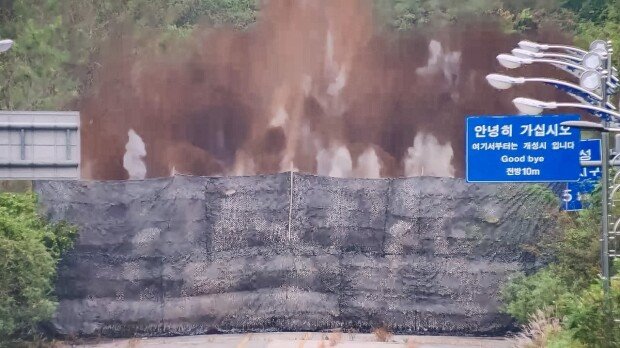N. Korea builds 11-meter rampart after road demolition
N. Korea builds 11-meter rampart after road demolition
Posted November. 05, 2024 08:05,
Updated November. 05, 2024 08:05


On October 15, North Korea dug large craters along the Gyeongui and Donghae Lines using TNT explosives. Following the demolition, the North erected retaining walls and piled earth into low mounds, ostensibly to prevent tank advancements. The South Korean military, however, described the action as “a symbolic show to highlight the severance between the two Koreas.”
The Joint Chiefs of Staff (JCS) reported on Monday that North Korea had deployed 300-400 troops daily, alongside excavators, bulldozers, and other heavy machinery, to construct concrete anti-tank ditches where the Gyeongui and Donghae Line roads and railways once stood. According to the JCS, this project was completed last Friday.
Photos released by the JCS depict the recently completed anti-tank ditch on the Donghae Line, which spans 160 meters in length, 10 meters in width, and 5 meters in depth. North Korean forces also built an adjacent mound, 5 meters high and 50 meters wide, on the ditch's northern side, and planted trees atop it. A concrete retaining wall separates the anti-tank ditch from the mound, preventing soil erosion.
In a similar move, North Korea dug an anti-tank ditch on the Gyeongui Line, measuring 120 meters in length, 10 meters in width, and 3 meters in depth. To the north of this ditch, they constructed an 11-meter-high, 45-meter-wide mound, again planting trees on top and adding a retaining wall at its base to stabilize the structure.
On Friday, after completing the construction on the Donghae Line, North Korean forces briefly raised their national flag atop the newly created mound, photographing it before subsequently removing the flag. South Korean surveillance equipment captured this display.
South Korean military officials view North Korea’s efforts as an attempt to create obstacles to deter any potential tank maneuvers by South Korean or U.S. forces heading north. “This construction of anti-tank ditches does not imply that North Korea has renounced the possibility of future conflict,” said a JCS spokesperson clarified. “At any time, North Korea could quickly level these mounds to fill the ditches, thus opening a pathway for an incursion.” The spokesperson assessed that these anti-tank ditches hold no practical military utility; the flag placement was simply a show to assert North Korea’s claim to the area and symbolize the completion of their isolation measures.
Some analysts speculate that North Korea’s road and railway blockades, reinforced with retaining walls, may also serve a secondary purpose within military circles. With potential internal unrest and large troop deployments to Russia, some suggest the North’s actions aim to preemptively close off defection routes.
Hyo-Ju Son hjson@donga.com
Headline News
- Kim Jong Un: Negotiations with U.S. have gone to the limit
- Yoon’s support rating remains at 20% for two weeks in a row
- SEC chair known for cryptocurrency regulations announces resignation
- Medical student scores 398 on CSAT, signaling ‘applications for reach schools’
- Noh Kyung-eun to play up to three more years with SSG







